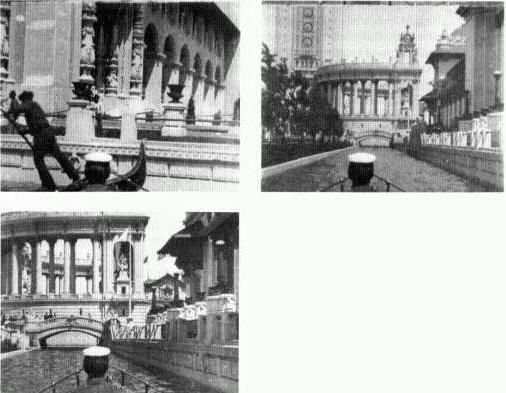Spring 1901
That spring, Edison production moved back outside the studio. Porter probably took Buffalo Bill's Wild West Show Parade , which "shows Buffalo Bill and his family of Rough Riders on their triumphal entry in New York, April 1, 1901."[38] Over the following weeks, Wild West Show performances in Madison Square Garden included "the hold-up of the Deadwood Stage."[39] This may have inspired or even provided the necessary actors and props for another Edison film made that spring—Stage Coach Hold-up in the Days of '49 :
This scene will give you a good idea of the desperate "Hold-Ups" that occurred on the plains when the rush was made to the new gold fields in '49. It shows the desperadoes coming from ambush, covering the driver of the stage with Winchester rifles and ordering him to halt. The occupants of the coach are compelled to dismount from their places, and are lined up in a very realistic manner with their hands thrown up. The outlaws get all the booty they can, and are just departing when an armed Sheriff's posse arrives. They pursue the bandits and after a desperate chase and a brutal conflict, capture them and return to the scene of the robbery. The bandits are then forced at the points of revolvers to ride in front of the coaching party to Dad's Gulch, a mining town, where they are safely landed in the lock-up. This picture will joyously intoxicate any audience, and deafening applause for an encore will be certain. Length 150 ft.[40]
Stage Coach Hold-up might answer several historical questions even as it raises others. It is a possible model for the British film Robbery of a Mail Coach (September-November 1903) as well as a precursor of Porter's later The Great Train Robbery .[41] While the description may be a somewhat expansive version of what was actually shown on the screen, the picture could have contained as many as four shots. Unfortunately it is a lost film and the catalog description
A Trip Around the Pan-American Exposition makes use of the viewer-as-passenger convention.
provides no certain answers to its possible construction. The historian must look elsewhere to trace the development of film narrative at Edison.
After the success of its Paris Exposition subjects, the Edison Company spent considerable energy securing films of the Pan-American Exposition in Buffalo, New York. Again a mobile camera was heavily employed. A camera crew, probably including James White as producer and Edwin Porter as photographer, took the two-shot Opening, Pan-American Exposition , showing a parade of dignitaries and soldiers, on May 20th. This was soon followed by A Trip Around the Pan-American Exposition , a 625-foot subject photographed from a launch making a tour of the exposition's canals. The camera was assigned the role of privileged passenger and took in all the sights. This popular subject was also sold in 200, 300, 400, or 500-foot strips, depending on the desires of the exhibitor. For Panoramic View of Electric Tower from a Balloon , the camera caressed the electric tower with a vertical tilt up and down, recalling White's earlier treatment of the Eiffel Tower in Panorama of Eiffel Tower . The title
and catalog description, however, urged exhibitors to test their patrons' imagination—or gullibility: the camera, it was suggested, had been in a captured balloon that moved up and down next to the tower. By the beginning of June they had accumulated over twenty films, including Johnstown Flood, Aerio-Cycle , and Trip to the Moon —short scenes taken of specific attractions.[42] Once again, these were designed for longer, theme-oriented programs in which exhibitors asserted an authorial role. To facilitate these efforts, the Edison firm published a "Pan-American Supplement" that provided full descriptions of each film as material for the showman's live narration.[43]
A significant group of photographers were associated with the Edison Company by early 1901. Although William Paley was the only surviving licensee on the East Coast, William Wright or some other Edison-affiliated cameraman must have filmed President McKinley launching the battleship Ohio in San Francisco before a crowd of 50,000 cheering people.[44] Since late 1898 James White may occasionally have served as his own cameraman, but more typically he worked with Porter or Alfred C. Abadie when producing news films and actualities. Porter may have emerged as the only close to full-time Edison camera operator. The extent to which his collaboration with George S. Fleming continued outside the studio is unknown. Two Edison production units were active on May 30th, Decoration Day: Porter was probably in Ithaca, New York, taking Cornell-Columbia-University of Pennsylvania Boat Race , while another unit was at an amusement park filming Shooting the Chutes at Providence, Rhode Island .
While Edison cameramen were filming actualities all over the northeastern United States, Porter spent much of his time producing short comedies and trick films at the Edison studio and in nearby locations. Building Made Easy, or How Mechanics Work in the Twentieth Century (85 feet) used stop and reverse action to show a bricklayer and carpenter working effortlessly, constructing a building in ways that defied gravity. The building of New York's subway was the premise for The Finish of Michael Casey , yet another explosion film. Little Willie's Last Celebration , made to commemorate the Fourth of July, likewise ends with Willie in smithereens. Unfortunately these pictures were not copyrighted and do not survive.[45]
